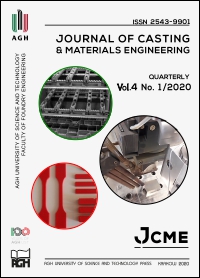Surface Remelting of Mold Inserts Made of NC11 Steel
DOI:
https://doi.org/10.7494/jcme.2020.4.1.9Abstract
In the study presented in this paper, the effect of a concentrated heat stream on geometry, microstructure, and hardness of superficial remeltings on NC11 steel is examined. The material is used for disposable mold inserts exposed to intensive abrasive wear in the course of the press-molding of hard aggregate stampings for refractory bricks. As a result of local remelting, the hardness of the steel surface increased and its microstructure was altered. Macro- and microstructure of the remelted areas was examined with the use of optical microscopy and measurements of remelting area geometry were carried out for different parameters of the remelting process. Hardness measurements were taken in the remelting area and in the heat-affected zone. The state of stress in the material before remelting and in the remelted area was also evaluated.
Downloads
References
Orłowicz A., Mróz M., Tupaj M., Kupiec B., Trytek A., Sondej K.
& Kozak L. (2016). A device for evaluation of scratch resistance of die inserts used to fabricate stampings of refractory materials. 15 International Technical Systems Degradation Conference, Liptovský Mikuláš, 30 March – 2 April 2016,
vol. 1, 70–73.
Orłowicz A., Mróz M., Tupaj M., Trytek A., Kupiec B., Korzeniowski M., Pająk D., Sondej K. & Kozak L. (2016). An assessment of appropriateness of the choice of parameters for refractory stampings fabrication process. Archives of Foundry Engineering, 16 (2), 55–60.
Orłowicz A., Mróz M., Tupaj M., Trytek A., Kupiec B., Korzeniowski M., Cisek Z., Sondej K. & Kozak L. (2006). Determination of unit pressure force in material volume in the course of refractory stamping press moulding. Archives of Foundry Engineering, 16 (2), 61–68.
Orłowicz A.W., Mróz M., Tupaj M., Trytek A., Kupiec B., Korzeniowski M., Sondej K. & Kozak L. (2016). The Effect of Carbides Orientation in NC11 Steel on Scratch Susceptibility of Die Inserts Used to Press Stampings for Refractory Shapes. Archives of Foundry Engineering, 16 (2), 95–98.
Orłowicz A., Mróz M., Tupaj M., Kupiec B., Kozak L. & Kij T. (2017). Application of ceramic coating to improve abrasive wear resistance of die inserts used to press-mould stampings of refractories. Metalurgija, 56 (3–4), 415–418.
Orłowicz A.W., Trytek A. & Malik J. (2013). Formation of microstructure and service properties of cast iron castings by surface improvement with electric arc plasma. Rzeszów: Oficyna Wydawnicza Politechniki Rzeszowskiej.
Orłowicz A.W., Tupaj. M., Mróz. M., Trytek A. & Betleja J.J. (2011). Kalorymetr przepływowy do pomiarów cieplnych w procesach spajania. Patent no. 211283, 16.11.2011.
Sondej K., Kozak L., Orłowicz A., Mróz M., Tupaj M., Trytek A., Kupiec B. (2016. A Mould insert with extended service life for press-moulding of stampings. Patent no. 16460035.5-1362, 02.06.2016.
Kim C.K., Lee S. & Jung J. (2006). Effects of heat treatment on wear resistance and fracture toughness of duo-cast materials composed of high-chromium white cast iron and low-chromium steel. Metallurgical and Materials Transactions A, 37, 633–643.
Chang K.K., Sunghak L. & Jae-Young J. (2006). Effects of Heat Treatment on Wear Resistance and Fracture Toughness of Duo-Cast Materials Composed of High Chromium White Cast Iron and Low-Chromium Steel. Metallurgical and Materials Transactions A, 37A, March, 633–643.
Pinedo C.E. & Monteiro W.A. (2001). Surface hardening by plasma nitriding on high chromium alloy steel. Journal of Materials Science Letters, 20, 147–149.
Larson J.A., Fischer R.B. (1982). Precipitation hardening chromium steel casting alloy U.S. Patent Apr. 27, 4,326,885.
Adetunji O.R., Musa A.A. & Afolalu S.A. (2015). Computational Modelling of Chromium Steel in High Temperature Applications. International Journal of Innovation and Applied Studies, 12 (4), 1015–1021.
Tillmann W., Schaak C., Hagen L., Mauer G. & Matthäus G. (2019). Internal Diameter Coating Processes for Bond Coat (HVOF) and Thermal Barrier Coating (APS) Systems. Journal of Thermal Spray Technology, 28 (1–2), 233–241.
Seshadri R.C. & Sampat S. (2019). Characteristics of Conventional and Cascaded Arc Plasma Spray-Deposited Ceramic Under Standard and High-Throughput Conditions. Journal of Thermal Spray Technology, 28 (4), 690–705.
Yingchun Xie, Chaoyue Chen, Marie-Pierre Planche, Sihao Deng, Renzhong Huang, Zhongming Ren & Hanlin Liao. (2019). Strengthened Peening Effect on Metallurgical Bonding Formation in Cold Spray Additive Manufacturing. Journal of Thermal Spray Technology, 28 (4), 769–779.
Aghasibeig M., Tarasi F., Lima R.S., Dolatabadi A. & Moreau C.
(2019). A Review on Suspension Thermal Spray Patented Technology Evolution. Journal of Thermal Spray Technology, 28 (7), 1579–1605.
Nowotny S., Scharek S., Beyer E. & Richter K.H. (2007). Laser Beam Build-Up Welding: Precision in Repair, Surface Cladding, and Direct 3D Metal Deposition. Journal of Thermal Spray Technology 16 (3), 344–348.
Orłowicz A. & Mróz M. (2003). Microstructure and fatigue strength of A 356 alloy castings refined on the surface by rapid crystallization. Zeitschrift für Metallkunde, 94 (12), 1320–1326.
Orłowicz A. & Trytek A. (2003). Effect of rapid solidification on sliding wear of iron castings. Wear, 254, 154–163.
Orłowicz A. & Trytek A. (2003). A Susceptibility of iron castings to heat absorption from electric arc and to hardened-layer shaping. Metallurgical and Materials Transactions, 34A, 2973–2984.
Mróz M., Orłowicz A. & Tupaj M. (2013). Stress-rupture Tests of MAR-M-509 Cobalt Alloy Improved by Rapid Solidification. Archives of Foundry Engineering, 13 (1), 117–120.
PN-EN ISO 4957:2018-09 – Stale narzędziowe.
Hebda M. & Wachal A. (1980). Trybologia. Warszawa: WNT, internet edition by: Polskie Towarzystwo Trybologiczne 2005, http://www.tribologia.eu/ptt/try/tr.htm
Nastaj T. (2003). Badanie odporności na zużycie ścierne powłok napawanych stopami na bazie niklu. Eksploatacja i Niezawodność, 2, 49–51.
Pytko S. (1982). Problemy wytrzymałości kontaktowej. Warszawa: PAN.
Downloads
Published
Issue
Section
How to Cite
Accepted 2020-02-20
Published 2020-03-31


